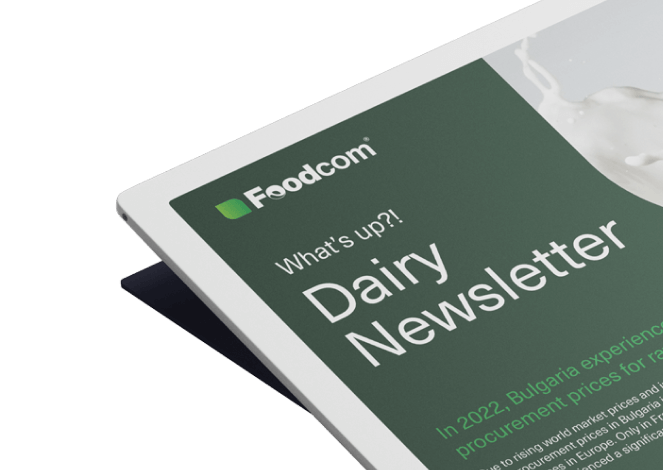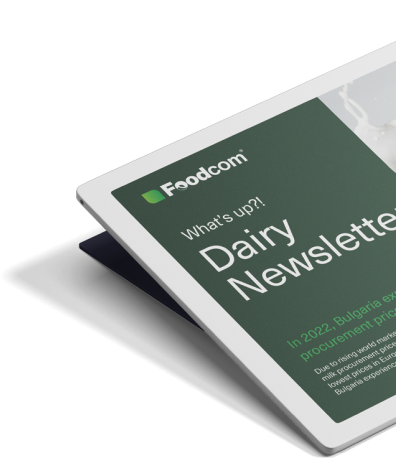Sintesi
Indice
Last week brought a lot of news on the dairy market and obviously some price fluctuations. In this issue of our newsletter we have prepared for you some longer insights into the selected commodities, so you have the opportunity to get to know them first.
In the case of this week’s product overview, we can recall the quote by Miguel de Cervantes: ‘Take away the cause and the effect ceases’. This phrase can be perfectly applied to the functioning of the market, as we observe that the prices we are currently dealing with depend on many different factors, including the weather, the mood of buyers and others. Be sure to check our view on these processes.
What is happening in different parts of the world when it comes to dairy products? As always, it’s up to the region. There’s a lot going on in the Americas, where we are seeing numerous unexpected events. As for Europe, Asia and Oceania… we will not give it all away in the introduction.
Continue reading to learn about this week’s market insights.
With us, you’ll never miss a thing!
Another week in a row, the commodity cream has experienced a price correction. There is plenty of this material on the market and no problems with availability, which translates into lower prices for Butter among producers. Unfortunately, there are more sellers with filled warehouses than prospective buyers. This is also related to the fact that some buyers have already gone on vacation. Nevertheless, we had quite a lot of interest for butter with Q3 deliveries last week.
Despite the hot weather in many regions of Europe and the resulting drought, raw material as such is abundant. As a result, the price of Skimmed Milk Concentrate has fallen for another week in a row, and the commodity is available in France at just below 2000 EUR/MT. Trading houses offer the product already produced and therefore it is difficult to get a relatively good price for the fresh product.
Cheese has been the hottest commodity on the market in recent weeks. We have had a lot of inquiries about these products. The great interest has also been reflected in a high volume of contracts signed. Particular activity and interest in these products were shown by tourist countries, which have to satisfy the needs of holidaymakers.
In the last two weeks, some producers have increased prices for WPC 80% by almost 10%, as interest has increased, especially from outside the European Union. Producers have raised prices and some customers have backed out as they have not been able to pay the required prices. This is also because they are still expecting deliveries from previous contracts, where the price started at 4.
The price of the commodity has fallen and the availability is very good, which is typical for this period.
In the case of this week’s product overview, we can recall the quote by Miguel de Cervantes: ‘Take away the cause and the effect ceases’. This phrase can be perfectly applied to the functioning of the market, as we observe that the prices we are currently dealing with depend on many different factors, including the weather, the mood of buyers and others. Be sure to check our view on these processes.
What is happening in different parts of the world when it comes to dairy products? As always, it’s up to the region. There’s a lot going on in the Americas, where we are seeing numerous unexpected events. As for Europe, Asia and Oceania… we will not give it all away in the introduction.
Continue reading to learn about this week’s market insights.
With us, you’ll never miss a thing!
Butter
Another week in a row, the commodity cream has experienced a price correction. There is plenty of this material on the market and no problems with availability, which translates into lower prices for Butter among producers. Unfortunately, there are more sellers with filled warehouses than prospective buyers. This is also related to the fact that some buyers have already gone on vacation. Nevertheless, we had quite a lot of interest for butter with Q3 deliveries last week.
Skimmed Milk Powder
Despite the hot weather in many regions of Europe and the resulting drought, raw material as such is abundant. As a result, the price of Skimmed Milk Concentrate has fallen for another week in a row, and the commodity is available in France at just below 2000 EUR/MT. Trading houses offer the product already produced and therefore it is difficult to get a relatively good price for the fresh product.
Gouda/Edam
Cheese has been the hottest commodity on the market in recent weeks. We have had a lot of inquiries about these products. The great interest has also been reflected in a high volume of contracts signed. Particular activity and interest in these products were shown by tourist countries, which have to satisfy the needs of holidaymakers.
Whey Protein Concentrate 80%
In the last two weeks, some producers have increased prices for WPC 80% by almost 10%, as interest has increased, especially from outside the European Union. Producers have raised prices and some customers have backed out as they have not been able to pay the required prices. This is also because they are still expecting deliveries from previous contracts, where the price started at 4.
Cream
The price of the commodity has fallen and the availability is very good, which is typical for this period.
Categorie







